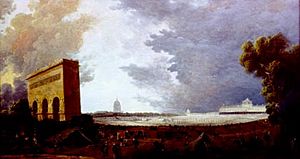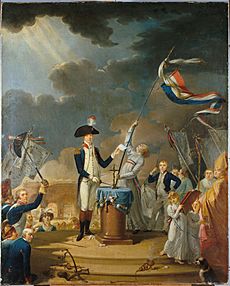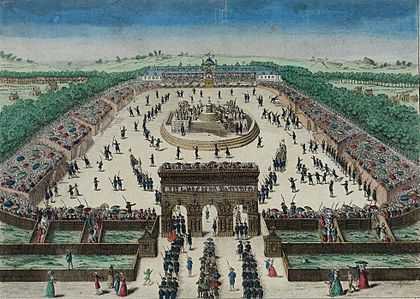Fête de la Fédération facts for kids
The Fête de la Fédération, or Festival of the Federation, was a huge celebration across France in 1790. It honored the French Revolution and the new sense of national unity. This festival was the first version of what we now call Bastille Day. Bastille Day is celebrated every year in France on July 14th. It marks the Revolution and brings people together.
The festival remembered the big changes of 1789. These changes led to a new type of government in France. It became a constitutional monarchy, meaning a king ruled alongside an elected group called the Assembly. The first fête in 1790 happened on July 14th. This date was chosen to be on the first anniversary of the storming of the Bastille. However, the festival itself celebrated unity, not just the storming of the prison. At this time, many people thought the big political struggles were over. Even those who wanted the king to keep more power encouraged this idea. The festival was planned to include King Louis XVI in a way that respected his role. The event was peaceful. It showed a strong, but perhaps not entirely real, picture of France being united after the difficult events of 1789 and 1790.
Contents
Why the Festival Started
After the first big changes of the Revolution in 1789, France moved from its old system, called the ancien régime, to a new one. This new system was a constitutional monarchy. By the end of 1789, towns and villages all over France began to form "federations." These were like friendly groups that celebrated and supported the new government.
A common idea among these groups was to have a big national celebration. They wanted a fête to honor the Revolution and show unity. Plans were made for celebrations to happen at the same time across the country in July 1790. But the main event would be in Paris. The King, the royal family, and all the members of the National Constituent Assembly would be there. Thousands of citizens from all over France were expected to join.
Getting Ready for the Big Day

The festival took place at the Champ de Mars. This large field was outside Paris at the time. The National Assembly paid for the huge stadium to be built. It was finished just in time. Thousands of volunteers from the Paris area helped build it. These days were known as the "Wheelbarrow Days" (journée des brouettes). During this time, the workers made a new song popular. It was called Ah! ça ira, and it became a famous French anthem.
Giant dirt stands were built on both sides of the field. They could hold an estimated 100,000 people. A bridge made of boats crossed the Seine River. This led to an altar where people would make their promises. The new military school nearby was used to house members of the National Assembly and their families. At one end of the field, a large tent was set up for the king. At the other end, a triumphal arch was built. In the middle of the field, there was an altar for the church service.
The Official Celebration
The festival started very early, at four in the morning. It rained heavily all day, even though the Journal de Paris had predicted "frequent downpours."
Fourteen thousand "fédérés" came from different parts of France. Every National Guard unit sent two men out of every hundred. They marched under eighty-three different flags, one for each French département. They gathered where the Bastille prison once stood. Then they marched through several streets before crossing the temporary bridge to the Champ de Mars.

A church service was led by Charles Maurice de Talleyrand. He was the bishop of Autun. At this time, the first French Constitution was not yet finished. It would not be officially approved until September 1791. But everyone understood what it meant, and they didn't want to wait. Lafayette led the President of the National Assembly and all the deputies in a serious promise to the coming Constitution:
We swear to be forever faithful to the Nation, to the Law and to the King, to uphold with all our might the Constitution as decided by the National Assembly and accepted by the King, and to remain united with all French people by the indissoluble bonds of brotherhood.
After this, King Louis XVI made a similar promise. He said: "I, King of the French, swear to use the power given to me by the constitutional act of the State, to maintain the Constitution as decreed by the National Assembly and accepted by myself." The title "King of the French" was used here for the first time. Before, he was called "King of France (and Navarre)." This new title showed that the king's power came from the people of France, not just the land. Then, Queen Marie Antoinette stood up. She showed the Dauphin, her son and future Louis XVII. She said: "This is my son, who, like me, joins in the same sentiments."
The festival organizers welcomed groups from many countries. This included the recently formed United States. John Paul Jones, Thomas Paine, and other Americans were there. They proudly displayed their Stars and Stripes flag at the Champ de Mars. This was the first time the American flag was flown outside the United States.
A Festival for Everyone
After the official ceremony, the day ended with a huge public party. It also showed the coming together of the Three Estates of France. These groups had been in heated discussions during the Estates-General of 1789. Now, the Bishop (First Estate) and the King (Second Estate) were blessing the common people (Third Estate).
In the gardens of the Château de La Muette, a meal was served to over 20,000 people. There was lots of singing, dancing, and drinking. The celebrations continued until July 18th.
Fun Facts About the Festival
- The song Chant du 14 juillet was written for this event. It was composed by Marie-Joseph Chénier and François Gossec. This song was sung in French schools until World War II.
- Jean Claude Jacob, a very old man from the Jura Mountains, was brought to the festival. He was supposedly 120 years old. He was called the "Dean of the Human Race."
Related pages
See also
 In Spanish: Fiesta de la Federación para niños
In Spanish: Fiesta de la Federación para niños


